
Health 'Insurance' at Sea: 1 2 3 4 5 6 7 8 9 10 11 12 13 Next>>
Health 'Insurance' at Sea During the Golden Age of Piracy, Page 10
Long-Term Health Care - Navy
Just as was true for the other types of health care leading up to and available during the golden age of piracy, the English Navy had the most comprehensive plans for long-term care. These took three forms. The simplest was to offer employment to men crippled in the service of the navy. The second was to provide payments, either one time lump sum or annual pensions, to care for those ill and wounded. This was done for navy men through two different mechanisms: the County Relief Pension program and the Chatham Chest program. The third was to provide a home for them in the Greenwich hospital which opened in 1705 and gradually replaced the Chatham Chest program.
Long-Term Health Care - Navy Post-Injury Employment
One of the methods for dealing with those injured during naval service was to find them employment with
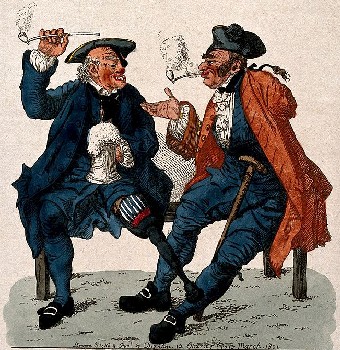
Artist: Robert Dighton (Self Portrait)
A Greenwich and Chelsea Pensioner Telling Each Other Stories
From the
Wellcome Collection (1801)
the government. This was often done for those who had had limbs amputated, which usually made a sailor incapable of being an effective 'before-the-mast' man. This is why Nathaniel Uring's merchant sailors protested for payment before they battled a privateer, for "if they lost a Leg or a Arm, they must be Beggers all their Life after."1
The various wars that England entered into during the latter half of the 17th century created a large number of disabled men.2 Having such men begging in the streets as a result of wounds received through their service reflected badly on the government and discouraged other sailors from serving or placing themselves in harm's way when they did serve. In addition, many of these men were young, so it was to both the navy's and society's benefit that such men be found useful employment.
In March of 1653, the officers of the fleet petitioned the generals that disabled naval sailors "should remain the state's servants 'in what they are capable' and that they should continue in pay."3 Although 'the employment of invalids' could not be wholly met by the available jobs, it was an attempt to give them gainful work. It also created a template for similar future efforts.
Perhaps one of the most iconic images of naval amputees from this and later periods is as the ship's cook. Historian John Keevil explains that this was "the means by which humanity and economy could be combined"4. Sea surgeon Hugh Ryder tells of a such a sailor he treated on a third rate naval ship,
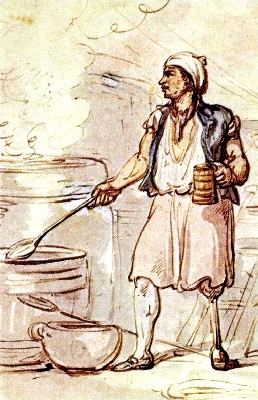
Artist: Thomas Rowlandson - Royal Navy Cook (1799)
who upon the Recoil of a Gun [cannon] the Truck ran over his Foot, breaking in pieces all the Bones of the Metatarsus, there was a necessity to take off his Leg, to which he readily agreed; so he hopp' d on one Leg to a Chest, where sitting I took it off, (he not expressing the least sign of pain or sorrow,) and afterwards when well, was by his Majesties favour made Cook of a Second Rate Ship.5
This practice of employing disabled sailors on ships in such a capacity was ordered after the end of William's War as well. In October of 1697, the Admiralty requested the Navy Board "to 'give orders for the bearing of cripples upon his Majesty's ships according to the custom of the Navy in time of peace', preference being given to those with longest service and those who were being discharged from ships paying off."6
The employment of cooks seems fairly straightforward, but Keevil explains that
it proved a continuous source of perplexity and raised more problems than it solved. When the fleet was in harbor, the one-legged, one-armed cooks combined in advancing all manner of schemes, at one time suggesting that their difficulties would be met if they were allowed to establish a nautical school of cookery, when their ship's duties could be carried out by their apprentices."7
There was an additional problem which was already mentioned - the one of numbers. After the Second Dutch War, the Admiralty board met with the King, Prince Rupert of the Rhine and 'high officers of the State' about the issue of there being so many disabled men from the war. Samuel Pepys noted that

Artist: John Hayls - Samuel Pepys (1666)
because the war was over, the size of the fleet had been reduced and there "were not enough ships to bear 'the great number of seamen cripples', except for the occasional cook's place as vacancies
occurred."8 Pepys suggested such men be given preference over other applicants for "filling vacancies in hospitals and almshouses, where those vacancies were in the King's gift. This was agreed and the Governors of the Chest were directed to prepare a list of seamen who had lost limbs in the King's service."9
The lack of positions available on naval ships after the Second Dutch War also led to the idea that invalid sailors could be put to work onto merchant ships (presumably in the role of cooks).
It soon became clear, however, that the authorities had been guilty of wishful-thinking, and on March 7, 1674, the Admiralty referred "to the officers of the Navy the considering of some proposition by which some of the poor seamen who by loss of their limbs in the King's service are unable to provide themselves in merchant ships, may in charity wish least burden to his Majesty be entertained in time of peace on board those of his Majesty's ships which shall be abroad'.10
Although the reason for the inability to get the merchants to employ disabled men isn't explained, it may be due to the fact that they typically sailed with the smallest crew possible. As a result, a merchant cook would likely have other duties which required climbing the rigging, firing the cannons and similar active duties.
Some permenantly injured seamen were employed in land-based positions. Soldiers and sailors who were granted county-based pensions (explained in the next section) "were expected, if at all possible, to work however affected in body by their wartime experiences."11 This was also done to increase their income. Although the county records are very incomplete, in Devon county at least "pensioners were employed as county postmen and house of correction governors."12
1 Nathaniel Uring, A history of the voyages and travels of Capt. Nathaniel Uring, p. 66; 2,3 John J. Keevil, Medicine and the Navy 1200-1900: Volume II – 1640-1714, p. 74; 4 Keevil, p. 138; 5 Hugh Ryder, New Practical Observations in Surgery Containing Divers Remarkable Cases and Cures, p. 91-2; 6 Keevil, p. 202; 7 Keevil, p. 138; 8 C.G. Lewin, Pensions and Insurance Before 1800 A Social History, 2003, p. 230; 9 Lewin, p. 230-1; 10 Keevil, p. 137; 11 Geoffrey L. Hudson, “Disabled Veterans and the State in Early Modern England”, Disabled Veterans in History, David A. Gerber, ed., 2015, p. 136; 12 Hudson, p. 135
Long-Term Health Care - Navy County Relief Pension Program
"The [county relief] pension scheme was adopted in order to encourage Englishmen to fight and fight well, and reward their services rather than grant them charity. It was viewed as a practical preventative measure against desertion, evasion of impressments, and the unfortunate and all too public spectacle of former servicemen, destitute, maimed, and begging in the streets." (Geoffrey L. Hudson, “Disabled Veterans and the State in Early Modern England”, Disabled Veterans in History, David A. Gerber, ed., 2015, p. 119)
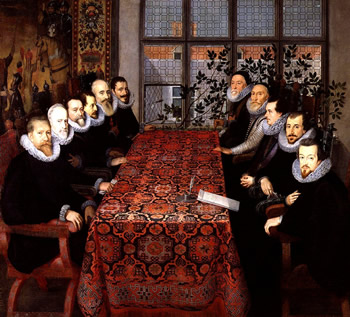
Elizabeth's Privy Council Meeting Spanish Embassadors (1604)
Although the initially volunteer-paid Chatham Chest (discussed on the next page) was the first program created for the long-term relief of Navy sailors in about 1588-1590, it didn't truly come into its own until the First Dutch War.1 Like the Chatham Chest, the county relief program was created due to the large number of wounded from the Anglo-Spanish War of 1585-1604. Its roots are found in efforts of the Privy Council - a standing, formal group of advisors to the English Sovereign (then Queen Elizabeth I) - who encouraged the towns and parishes of England to support their disabled veterans in 1591.2
Many of the wounded sailors and soldiers were in London during and after the war, having come with their brothers to seek back pay. "There is considerable evidence that maimed veterans themselves sought redress from members of Parliament. ...[Parliament member Michael Hickes] argued that 'the Poore soldiars you hear cry uppon us daylie in the stret for releif assure your self that they will cry out uppon us, yea curse us if we do nothing for them and, upbryd us that we have charity in our mouths, but none in our hands.'"2
In 1593, the Privy Council took more direct action for local support via an act which created a system of "compulsory parochial taxation to be administered on a countywide basis by special county treasurers and the Justices in court" for the relief of disabled men. As a result, "the Justices of the Peace have power yearly in their Easter Sessions to raise [pension funds] by way of a Taxe, for a weekly relief of maimed Souldiers and Mariners."3 The Privy Council noted that the need for this act was due to "England’s inadequate treatment of its ex-servicemen brought ‘dishonour to the Realme, in comparison to other Countries.'"4
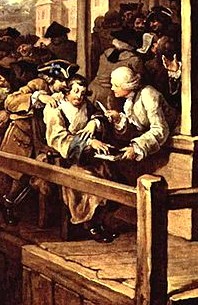
Artist: William Hogarth (1754-5)
The original 1591 act was amended in 1598 and then incorporated into a new act in 1601. The 1601 act "made relief for maimed ex-servicemen a right for which the payment of taxes was required by law."5 The actual pension amounts were up to the discretion of the county judges who awarded them. One document states that the allowances were to be not more than £10 for non-officers, £15 pounds for officers who had not yet reached the rank of lieutenant and £20 pounds for lieutenant.6 However, over-payment would prove to be an unlikely problem here.
For the first two decades of the program, qualified applicants were specified to be men who "had served in the military, had been physically maimed in service, and had been born in the county" where they were applying.7 The local execution of this plan did not match its national intent, however. "Although the Privy Council sought a strict and uniform execution of the act, it was not and could not have been successful because it was trying to achieve certain objectives with which the county magistrates fundamentally did not agree."8
Due to the unpopularity of the taxes imposed to finance this pension program and the limited funds with which county officials had to work, many limited the pensions awarded using need combined with disability rather than disability alone as a basis for granting pensions. Against the stated intent, local officials also granted one-time payments for wounds and even sent men to other counties to collect their pensions rather than raise county taxes to generate necessary funds "on legally spurious grounds".9 As a result, changes were made to the act in 1647 which allowed for pension award discretion based on need by local justices. However, there were still some discrepencies between the law and its application because of a lack of funds.10
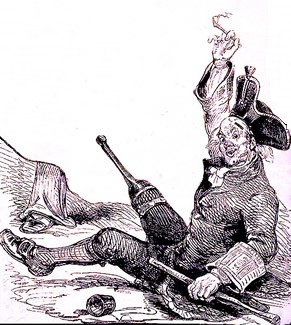
Artist:
J. Jackson
Pensioner With Spilled Drink & Pipe, Wellcome Collection
In the minds of county justices there was also a moral component to awarding pensions. They preferred not to grant pensions to vagabonds and convicted criminals, even though a large number of them had been press-ganged into service and were suffering from the same sorts of disabling wounds as their fellows. Pensions could also be revoked or amended in an attempt to discourage drunkards and misbehaving ex-servicemen. Such men "were precisely the kind of men justices wanted to discipline not pension, disabled or not, entitled or not."11 They disregarded the 1601 act which specified that the justices were specifically not allowed to modify pensions for any reason.12 However, this interest in the moral character of applicants appears to have gradually disappeared prior to 1642 as the justices' interests were focused elsewhere.
The process for application for county pensions in the latter half of the 17th century was outlined by Charles Molloy in his 1676 book De Jure Maritimo Et Navali.
The maimed Souldier or Mariner must repair to the Treasurer of the County where he was prest, if he be able to travel; if he was not, then to the Treasurer of the County where he was born, or where he last dwelt by the space of three Years; but if he proves unable to travel then to the Treasurer of the County where he lands.
He must have a Certificate under the chief Commander, or of his Captain, containing the particulars of his hurt and Services.13
Historian Geoffrey Hudson notes that the certificate was also "to be countersigned by the muster master general in London to prevent counterfeiting."14
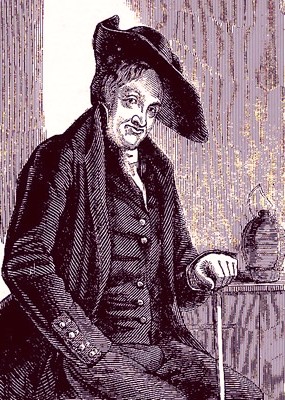
A Crafty Looking Pensioner, Wellcome Collection (1826)
Cheating was a particular problem with the county relief pensions as soldiers and sailors discovered ways to use this system to their advantage. "Ex-servicemen used and manipulated powerful friends to intercede with the local justices, combined (petitioned in groups), skillfully told the justices what they wanted to hear, and exploited institutional weaknesses (eg. magisterial amnesia)."15 Petitions to the court were often written by someone other than the man seeking a pension in a manner that would appeal to the justices awarding pensions.16
Inconsistencies in the rules about granting pensions created further opportunities for cheating. Pensions could be applied for in counties where disabled soldiers and sailors "had been born, had lived three years prior to service, or where they had been impressed."17 This allowed for another type of deceit. By comparing records of pensions awarded in different counties, historian Geoffrey Hudson found pensions had been granted to the same men in multiple places.18
To combat such dishonesty, changes were made to the original act in both 1647 and 1662 which were designed to help prevent the wounded servicemen from cheating . These modifications specified that men show "that they were ‘disabled in body for work’ and do so in the place in which they were last settled before taking up arms"19.
A number of reasons for granting county pensions were considered accepted by county justices. Surviving Somerset and Cheshire county records show that men with lost or disabled hands, arms and legs were frequently awarded pensions.20
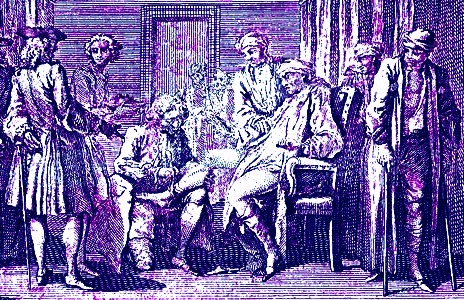
Artist: Richard Grey
The County Infirmary at Northampton, From the Wellcome Collection (1744)
Such wounds when tied to an inability to work, particularly for former tradesmen, were frequently recognized by justices as pension-worthy. Significant loss of blood which was connected to humor theory, was also used as reasonable grounds for pensions.21 Curiously, old age was similarly awarded22, possibly because it was related to need.
Although not as well known as the Chatham Chest, the county pension scheme appears to have been a success despite problems inherent in its execution. Hudson notes that "an estimate of the number of county pensioners in England, circa 1671, is 6,128 (6,557 in England and Wales)."23 However, inconsistencies of the program, difficulty imposing sufficient taxes and an increase in the number of permenantly wounded men from the Dutch Wars required the awarding of lower and lower pensions. By 1679, the Privy Council was no longer rigirously enforcing the county pension scheme. Both the success and better funding of the Chatham chest and the interest in establishing a hospital for invalid sailors led to the abandonment in most counties in the late 17th century.24
1 Geoffrey L. Hudson, “Disabled Veterans and the State in Early Modern England”, Disabled Veterans in History, David A. Gerber, ed., 2015, p. 122; 2 Hudson, p. 118; 3 Hudson, p. 120; 3 Charles Molloy, De Jure Maritimo Et Navali Or a Treatise of Affaires Maritime and of Commerce, 1676, p. 145; 4 Hudson, p. 121; 5 Hudson, p. 125; 6 Molloy, p. 145; 7 Hudson, p. 127; 8,9 Hudson, p. 124; 10 Hudson, p. 125; 11 Hudson, p. 124; 12 Hudson, p. 127; 13 Molloy, p. 145; 14 Hudson, p. 127; 15 Hudson, p. 128; 16 Geoffrey L. Hudson, "The Relief of English Disabled Ex-Sailors, c. 1590-1680", The Social History of English Seamen, 1485-1649, p. 241; 17,18 Hudson, "Disabled Veterans in History", p. 129; 19 Hudson, "Disabled Veterans in History", p. 127; 20 Hudson, "Disabled Veterans in History", p. 130; 21 Hudson, "Disabled Veterans in History", p. 132; 22 Hudson, "Disabled Veterans in History", p. 133; 23 Hudson, "Disabled Veterans in History", p. 123; 24 Hudson, "Disabled Veterans in History", p. 137

